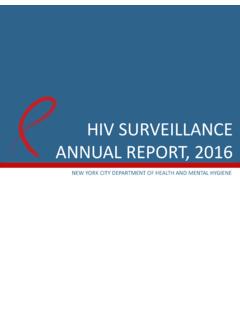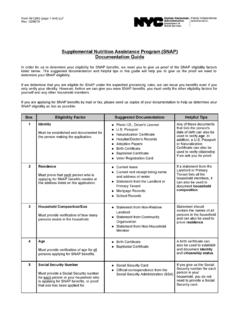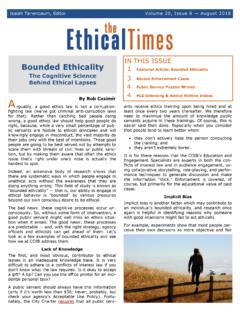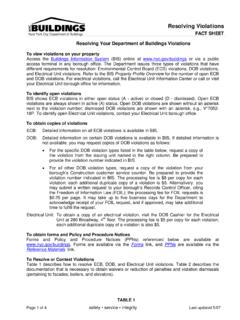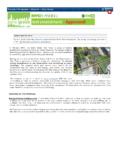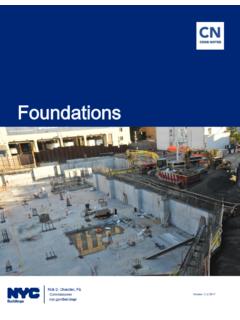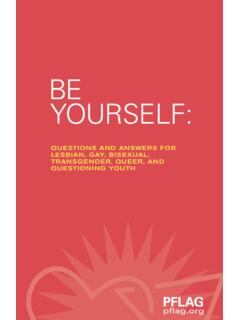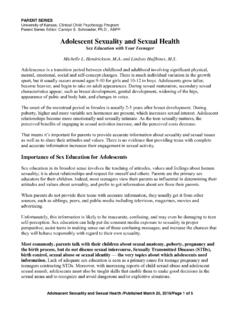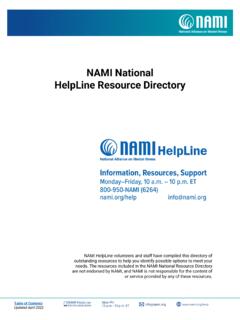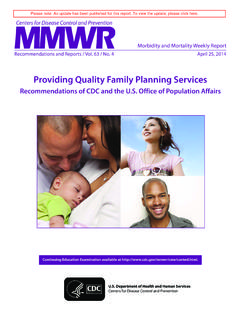Transcription of Respectfully Asking Sexual Orientation and Gender …
1 Respectfully Asking Sexual Orientation and Gender Identity (SOGI) Questions There are some circumstances when it is appropriate for staff to affirmatively try to provide an opportunity for youth to disclose their Sexual Orientation and/or Gender identity (SOGI). Often, this will be raised when discussing the need for residential and/or foster care placement options and medical and/or community supports. This information may also prove relevant to decisions regarding educational services, the PINS and delinquency diversion processes, disposition, reunification and placement. The purpose of this guidance is to assist staff members when they are unsure about how best to raise these issues with a child, youth and/or family member. Provider agency staff members are also encouraged to reach out to their agency s designated lgbtq Point Person for further guidance. 1. Professional Responsibilities. All ACS and provider staff must meet the individual needs of children, youth , and families regardless of their actual or perceived Sexual Orientation , Gender identity, Gender expression, or relationship/partnership status.
2 Discrimination on the basis of these categories is prohibited, and under no circumstance is any staff member to attempt to convince an lgbtq child or youth to reject or modify their Sexual Orientation , Gender identity, or Gender expression. Furthermore, staff members are prohibited from imposing their personal, organizational and/or religious beliefs on all families, including lgbtq children, youth or families. 2. Never Assume. Staff should not assume that all children and youth in care are straight ( heterosexual), non-transgender, or Gender conforming. Similarly, staff should not assume that lgbtq children or youth are identifiable by stereotypical mannerisms or characteristics. They should also avoid the assumption that all lgbtq children and youth have similar life experiences or share a common sense of community. They should examine their own beliefs and attitudes that might negatively impact their professional responsibilities to lgbtq children and youth , because all staff owe a professional duty to competent care to lgbtq youth .
3 3. Create an Affirmative Work Environment. Staff should create a positive environment in their work spaces that welcomes and affirms lgbtq people. Displaying recognizable symbols of support, such as rainbow flags, signals to lgbtq young people that they are in a safe, welcoming, and trusting setting and may be more likely to self-disclose their Sexual Orientation and/or Gender identity to staff when ready. 4. Use Appropriate Terminology. If a child, youth and/or family member discloses that they are lgbtq , all staff are required to show unconditional support by speaking with them about it utilizing appropriate, respectful, inclusive, and Gender -neutral Staff must also speak to the youth about circumstances in which 1 Examples of such language include, but are not limited to: lesbian, gay, bisexual, transgender, Gender non-conforming, Sexual Orientation , Gender identity, involved with someone, partner, spouse.
4 Please reference the pages 30-33 of the ACS lgbtq Policy, Promoting a Safe and Respectful Environment for 1the staff member may be required to disclose the lgbtq status of the child or youth , along with circumstances where the staff member will ask the child or youth for permission to disclose their Sexual Orientation and/or Gender identity. Staff should also be prepared to work effectively with transgender and Gender non-conforming (TGNC) youth and affirm their Gender identities in ways that are most appropriate for the youth , including referring to them by the names and pronouns they prefer and allowing them to dress, groom and express mannerisms consistent with their Gender identities. 5. Interviewing an lgbtq youth . lgbtq youth often experience hostility and rejection because of their actual or perceived Sexual Orientation or Gender identity this hostility and rejection may not be apparent to staff, so appropriate measures must be taken to speak privately with the youth during investigations.
5 The staff must use inclusive language signaling to the young person that they will be treated with dignity and respect regardless of their identity. 6. Interviewing the Parent/Caretaker. Only when the youth has already identified openly as lgbtq to the parents (or other primary caretaker) and the alleged abuse/and or maltreatment directly related to the child s perceived or actual Sexual Orientation , Gender identity and/or Gender expression shall the staff interview with parents include a discussion of the child s actual or perceived SOGI. In this instance, take the following measures: Focus the interview on eliciting from the parents their attitudes and beliefs about lgbtq people. Refrain from divulging to the parents any personal details the youth may have told the staff about their Sexual Orientation or Gender identity, without the express consent of the youth . If the parent displays negative attitudes about lgbtq people, even when deeply rooted in religious beliefs and cultural values, and the alleged abused and/or maltreatment are related to the youth s perceived or actual Sexual Orientation , Gender identity, or Gender expression, the staff must determine whether those attitudes are impacting the youth s immediate safety as well as whether those attitudes may put the youth at risk for future physical or emotional harm.
6 7. Always Maintain Confidentiality. lgbtq children and youth face great risk of abuse or neglect when their Sexual Orientation and/or Gender identity are disclosed to a parent or primary caretaker, particularly when the disclosure occurs without the youth s consent and/or in an inappropriate As such, information related to a child or youth s Sexual Orientation and/or Gender identity must be kept private, should not be shared with anyone without the child or youth s express consent, unless Lesbian, Gay, Bisexual, Transgender and Questioning ( lgbtq ) youth and their Families Involves in the Child Welfare, Detention and Juvenile Justice System for a glossary of appropriate terms, found at: 2 This often includes, but is not limited to, serious physical harm, homelessness, substance abuse and mental health conditions such as depression.
7 2otherwise authorized or required by law, and should be updated appropriately following the safeguards incorporated in CONNECTIONS. In general, staff are prohibited from disclosing a child or youth s Sexual Orientation and/or Gender identity to other individuals or agencies, without the child or youth s permission. Please note that some examples of permissible disclosure include, but are not limited to: if the information is necessary to determine safety or if a judge orders the disclosure. Staff shall inform child or youth during engagement of services and when age-appropriate of the need for their case record information to be shared with other legally authorized individuals, including but not limited to, the courts, school, medical services, agency staff, and all other legally authorized persons. Pursuant to state and federal laws governing confidentiality, staff are given information related to a child or youth s Sexual Orientation and/or Gender identity so that they may fulfill their responsibilities ( adequately provide services, and plan for the health , safety, permanency and well-being of youth and their families).
8 8. Implement Uniform Data Collection. All staff are encouraged to use intake forms that include age-appropriate questions about a child or youth s Sexual Orientation and Gender identity in demographic sections, but should not make it a requirement that children and youth answer these questions. This recommendation is directed to providers that already have some cultural competency with lgbtq children and youth . For consistency throughout the system, ACS endorses the following Sexual Orientation and Gender identity demographic questions: Gender Identity Questions o What is your sex? o Female o Male o When a person s sex and Gender do not match, they might think of themselves as transgender. Sex is determined at birth based on anatomy. Gender is how a person feels. Which one response best describes you? o I am not transgender o I am transgender and identify as a boy or man o I am transgender and identify as a girl or woman o I am transgender and identify in some other way o A person s appearance, style, dress, or the way they walk or talk may affect how people describe them.
9 How do you think other people would describe you? 3o Very feminine o Mostly feminine o Somewhat feminine o Equally feminine and masculine o Somewhat masculine o Mostly masculine o Very masculine o A youth has a right to use a preferred name and pronoun. Would you like us to use a preferred name? If yes, what? o What pronouns do you use? o Male pronouns ( he/him/his) o Female pronouns ( she/her/hers) o Other _____ o Do you feel safe, in light of your Gender identity or Gender expression? o Yes o No o If no, what are you most concerned about? Sexual Orientation Questions o Which of the following best describes you? o Straight (Heterosexual) o Lesbian o Gay o Bisexual o Asexual o Not Sure/Questioning o Do you feel safe, in light of your Sexual Orientation ? o Yes o No o If no, what are you most concerned about? 9. Identify Family Resources for lgbtq youth . Providers often assume that families of lgbtq children and youth are not supportive.
10 Many do not see families as a potential resource for helping their lgbtq children and youth attain permanency. The following are suggestions for providers to begin Asking lgbtq children and youth about their familial relationships: 4 5 How does your family react to your Sexual Orientation and/or Gender identity? Provide supportive counseling as needed, and connect youth with lgbtq community resources and programs listed in the ACS lgbtq Resource Guide found here: Are you aware of community and/or online resources for lgbtq youth and families? Be prepared to offer additional resources from the ACS lgbtq Resource Guide. Brainstorm positive family role models to help a family learn new ways to support and care for their lgbtq child and youth ( PFLAG and similar family support groups). Assess the level of family rejection and related health risks the lgbtq child or youth may be experiencing by using the Family Acceptance Project s mental health assessment Protocol screener found at: Refer and follow up with families, as needed, to provide education and family counseling.
